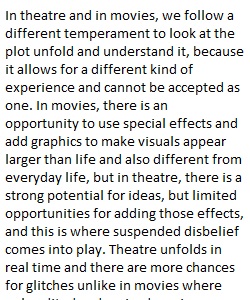


Q This week, we took a brief look at Shakespeare's The Tempest (see the Assignments section). This five-act play opens with a storm at sea (a tempest) and throughout, Shakespeare has planted allusions to apparitions and magic, such as the character Ariel who, at times, appears to be invisible to the other characters. It is a given that the special effects, such as those often used in films, to actually give the stage the appearance of a deadly tempest or actually make Ariel an invisible presence are not achievable on the stage. To fill in this gap, audiences suspend disbelief. In this thread, let's discuss the power and limitations of theatrical imagination. Please feel free to draw from productions you have seen. (The old high school productions count, too!) Why are we willing to suspend disbelief when we see a play, yet we demand so much more from a film production? Do you think that the limitation on special effects and alternative demand on the audience member to suspend disbelief is a weakness or a strength of the theatrical experience? Would you rather see The Tempest on stage or in film? Why?
View Related Questions